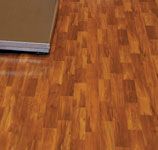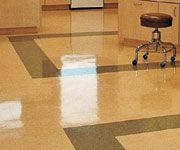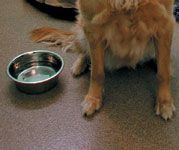The flooring dance
Marry the right flooring to the right part of your veterinary hospital and your entire practice will be perfectly in step. Install the wrong materials underfoot and the whole place will feel out of rhythm.
Marry the right flooring to the right part of your veterinary hospital and your entire practice will be perfectly in step. Install the wrong materials underfoot and the whole place will feel out of rhythm. If you make a flooring mistake, you can absolutely correct your error—but not until you've endured upheaval and grumbling staff members and clients, not to mention plenty of wasted money. So it's in your best interest to get your flooring right the first time. Think of the chart on the following pages as the dating stage: Take it slow, pinpoint your likes and dislikes, and don't make any proposals until you're absolutely sure.

First impressions: Porcelain tile welcomes visitors with a touch of class at Animal Medical & Surgical Center in Scottsdale, Ariz.

Illustration by Gail Armstrong.
Concrete
Cost: Least expensive

Durability: Long-lasting, but somewhat prone to chipping and cracking.
Maintenance: Regular resealing, especially in kennel areas to prevent urine absorption.
Your options: Various types of sealants and treatments, including alkali-and fade-resistant pigments and stain. Beware that the colors and patterns achieved with pigment dying and staining are uneven and unpredictable, so be sure you like the look.
Where to install it: Utilitarian areas, especially the kennel. Reserve stained concrete for public and reception areas; the stain doesn't stand up to the abuse it would receive in the kennel.
Tip: If you're longing for porcelain tile but your budget won't allow it, consider installing colored or stained concrete. It's less expensive and you can easily lay tile over it later when your budget allows.
Linoleum
Cost: Moderately expensive

Durability: Long-lasting, and hardens over time. Holes or gouges can be repaired by mixing in a paste.
Maintenance: Mopping with a dust mop or damp mop and a pH cleaner. Waxing typically isn't necessary.
Your options: This isn't the pea green and mustard yellow stuff of yesterday's kitchens. Today's linoleum allows for a wide array of colors and styles—all of them tasteful. What's more, linoleum can be coved up a wall.
Where to install it: Exam rooms and treatment and surgery areas—linoleum is antimicrobial. Avoid putting it in wet areas like the kennel.
Tip: Linoleum is an all-natural product that's made primarily from linseed oil, so it's a good choice if you're trying to be environmentally friendly. (For more ideas on building an earth-friendly practice, read "Seeing Green" in this issue.)
Sheet vinyl
Cost: Inexpensive, but higher-priced than VCT

Durability: Resilient; forgiving of dropped tools. Be sure to opt for heat-welded rather than chemically welded seams, because the latter come apart over time.
Maintenance: Frequent polishing and waxing to make it shine and remove scuff marks.
Your options: Wide array of colors and styles, but if you don't plan to wax regularly, choose a darker color. Designers often recommend choosing a color that matches the local dirt.
Where to install it: Working areas of the hospital, such as exam rooms and treatment and surgery areas. The seamless feature of sheet vinyl makes it more sanitary than its sister, VCT.
Tip: Installing a polyolefin barrier under the concrete slab serves as a vapor barrier and helps ensure that the vinyl stays adhered to the concrete. Vapor barriers are often required to get a flooring warranty.
Rubber
Cost: Moderately expensive

Durability: Long-lasting
Maintenance: None, aside from occasional cleaning. Black-soled shoes leave scuff marks on rubber. Use a tennis ball as an eraser: Rub the scuffs and voilà!
Your options: An ever-expanding array of colors and patterns, but the finish tends to be matte.
Where to install it: Treatment areas—rubber is antimicrobial and it provides a cushioned surface that's easy on hard-working feet and legs. It also comes in a variety of thicknesses, so you can order a thicker version if you need a padded floor in a dog exercise room, for instance.
Tip: European companies manufacture most rubber flooring, so the appearance is distinctly European, often featuring color chips that create a speckled look.
Bonus tip: Choose virgin instead of recycled rubber if you prefer that your flooring be nonporous.
Vinyl composition tile (VCT)
Cost: Inexpensive

Durability: Does not hold up to excessive water or wear, but is a smart low-cost option for moderately trafficked areas of the hospital.
Maintenance: Regular waxing to preserve the shiny finish and remove scuff marks.
Your options: Wide array of colors and patterns, but most designers recommend using a darker color to help hide scuff marks.
Where to install it: Front and working portions of the hospital, such as exam rooms and treatment areas. Avoid installing VCT in the kennel area.
Tip: Don't choose VCT if you're looking for a material that can be coved up the wall. With VCT, installers will lay a rubber or vinyl sheet base to cover the joint between the floor and the wall.
Porcelain tile
Cost: Most expensive

Durability: Strong and durable. Porcelain tile isn't impervious to scratches, so to make scratches less visible, choose a tile with color that goes all the way through rather than one with a color coating on top.
Maintenance: Virtually none except for normal cleaning, such as sweeping and mopping. It's possible to replace single tiles if necessary.
Your options: Infinite colors, textures, and patterns, plus it's easy to add borders, accent tiles, and even logos.
Where to install it: Front of the hospital, especially the reception area, because it's dressy. It can also be used in working areas of the hospital, but it's tiring to stand on for long periods of time.
Tip: Insist on epoxy grout, which resists urine. Choose a dark-colored grout and consider installing large tiles that measure at least 12 inches square to reduce grout lines and make cleaning easier.
Resinous
Cost: Expensive

Durability: Virtually indestructible if applied correctly.
Maintenance: Barely any, unless resinous flooring isn't installed correctly. To prevent problems, ask the installer to do a slab moisture test, properly prepare the subsurface, and complete a sample area for quality control.
Your options: Three recommended types of resinous flooring—cementitious urethane, trowelled epoxy, and acrylic—all of which are comparable overall. Cementitious is cement-based and generally has fewer color options, whereas trowelled epoxy and acrylic floors offer more choices, such as solid colors or speckled finishes.
Where to install it: Kennels or other wet areas. Consider using resinous flooring in the treatment and medical areas if you're looking for an indestructible surface.
Tip: Many resinous floors emit potentially dangerous odors during installation. If you're putting the floors in your existing facility, check whether you need to clear out people and pets first.
Also, be sure hire an installer with experience. Most, if not all, of the flooring options here require specialized expertise to ensure quality installation. Be sure you choose a flooring contractor who boasts a favorable reputation and a long list of successfully complete jobs.
Dance to your own beat when it comes to floors. The product that jives in the kennel might not mesh in the reception area. And the materials you've included in your hospital's playlist might not work for the practice down the road. But the most important flooring advice is this: Consider all your options before you tile a single aisle.
Heather E. Lewis is a partner with Animal Arts/Gates Hafen Cochrane in Boulder, Colo. Soak up more of her expertise by attending the Veterinary Economics Hospital Design Conference Aug. 20 to 22 in conjunction with CVC Central. To learn more, visit thecvc.com.

Heather E. Lewis